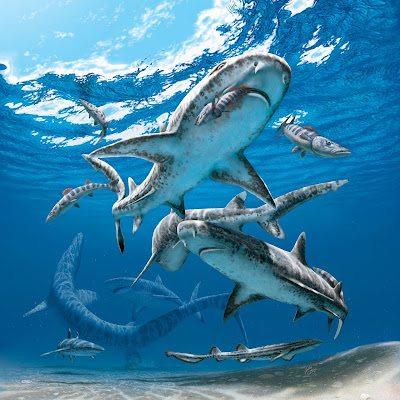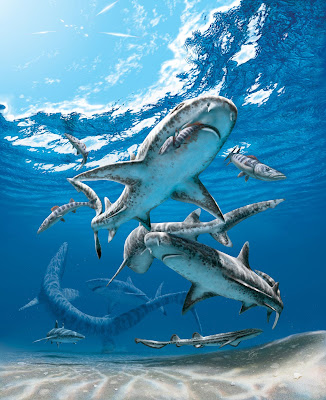| Bythaelurus stewarti Weigmann, Kaschner & Thiel, 2018 |
Abstract
A new deep-water catshark, Bythaelurus stewarti, is described based on 121 examined specimens caught on the Error Seamount (Mount Error Guyot) in the northwestern Indian Ocean. The new species differs from all congeners in the restricted distribution, a higher spiral valve turn count and in the morphology of the dermal denticles. It is distinguished from its morphologically and geographically closest congener, B. hispidus (Alcock), by the larger size (maximum size 44 vs. 39 cm TL, maturity size of males 35–39 vs. 21–28 cm TL), darker fresh coloration and dark grayish-brown mottling of the ventral head (vs. ventral head typically uniformly yellowish or whitish). Furthermore, it has a strongly different morphology of dermal denticles, in particular smaller and less elongate branchial, trunk and lateral caudal denticles that are set much less densely and have a surface that is very strongly and fully structured by reticulations (vs. structured by reticulations only in basal fourth). In addition, the new species differs from B. hispidus in having more slender claspers that are gradually narrowing to the bluntly pointed tip without knob-like apex (vs. claspers broader and with distinct knob-like apex), more spiral valve turns (11–12 vs. 8–10) and numerous statistical differences in morphometrics. A review of and a key to the species of Bythaelurus are given.
| Fig 1. Bythaelurus stewarti n. sp., holotype, ZMH 26251, adult male, 425 mm TL, in (A) lateral, (B) dorsal, and (C) ventral views. Scale bar: 5 cm. |
Bythaelurus stewarti Weigmann, Kaschner & Thiel n. sp.
Error Seamount Catshark
Diagnosis: A medium-sized Bythaelurus species with the following characteristics: body firm and slender; snout long (preorbital length 4.9–7.4% TL) and broad, bell-shaped in dorsoventral view with distinct lateral indention; pre-outer nostril length 0.6–1.4 times internarial space; preorbital snout length 0.7–1.1 times interorbital space; preoral snout length 0.8–1.7 times in mouth width; eye length 10.2–15.5 times in predorsal distance, 4.9–7.7 times in head length and 1.2–2.3 times eye height; head length 2.2–2.6 times width at level of maximum outer extent of anterior nostrils; head width at level of maximum outer extent of anterior nostrils 1.1–1.3 times width at level of lateral indention of head, 1.2–1.6 times preorbital length, and 8.1–10.1% TL; tongue and roof of mouth densely set with knob-like oral papillae; pelvic-fin anterior margin 1.6–3.5 times in pectoral-fin anterior margin; first dorsal-fin base 1.3–2.3 times in interdorsal space; length of second dorsal-fin inner margin 0.8–2.3 times in second dorsal-fin height; second dorsal-fin base length 5.1–8.9% TL; anal-fin base 0.7–1.9 times interdorsal space. Coloration: dorsally dark grayish-brown with rather indistinct dark blotches at nape, on flank, below both dorsal fins, and across caudal fin; ventral side grayish-white, usually with dark grayish-brown mottling on head. Upper jaw with 64–85 and lower jaw with 64–88 rows of small tricuspidate teeth with outer surface of crown furrowed by strong longitudinal ridges and strongly structured by reticulations; monospondylous trunk vertebrae centra 37–42, diplospondylous precaudal centra 37–45, total centra 125–140. Branchial, trunk and lateral caudal-fin dermal denticles loosely set, their surface very strongly and fully structured by reticulations. Claspers rather long and very slender, gradually narrowing to bluntly pointed tip without knob-like apex, inner margin length 10.1–11.3% TL, base width 1.4–1.5% TL; clasper hooks present along inner edge of large exorhipidion, large envelope overlapping part of clasper groove, inner lobe with rhipidion, cover rhipidion, pseudopera and pseudosiphon. The reproductive mode is yolk-sac viviparous. Bythaelurus stewarti n. sp. differs from all congeners in the distribution, which is apparently restricted to the Error Seamount. It further differs from all congeners in a higher spiral valve turn count (11–12 vs. 6–10) and in the morphology of branchial, trunk and lateral caudal-fin dermal denticles, which are loosely-spaced and not overlapping even in adult specimens of the new species, whereas they are closely-set and overlapping in all other Bythaelurus species. Compared to its morphologically and geographically closest congener, the new species further differs in a larger size, a ventral head with dark mottling, claspers that gradually narrow to the bluntly pointed tip without knob-like apex, and a surface of dermal denticles that is very strongly and fully structured by reticulations.
Distribution: The new species is known only from the Error Seamount (Mount Error Guyot) in 380–420 m depth (see map in the Discussion section). It is apparently a microendemic species restricted to this isolated Seamount.
Etymology: The new species is named after the late filmmaker and shark conservationist Rob Stewart, who inspired the second author and stimulated her interest in sharks.
Simon Weigmann, Carina Julia Kaschner and Ralf Thiel. 2018. A New Microendemic Species of the Deep-water Catshark Genus Bythaelurus (Carcharhiniformes, Pentanchidae) from the northwestern Indian Ocean, with Investigations of Its Feeding Ecology, Generic Review and Identification Key. PLoS ONE. 13(12): e0207887. DOI: 10.1371/journal.pone.0207887
---------------------------------------------------------------
روابط التحميل والمشاهدة، الروابط المباشرة للتحميل
او
شاهد هذا الفيديو القصير لطريقة التحميل البسيطة
كيف تحصل على مدونة جاهزة بآلاف المواضيع والمشاركات من هنا
شاهد قناة منتدى مدونات بلوجر جاهزة بألاف المواضيع والمشاركات على اليوتيوب لمزيد من الشرح من هنا
رابط مدونة منتدى مدونات بلوجر جاهزة بآلاف المواضيع والمشاركات في أي وقت حــــتى لو تم حذفها من هنا
شاهد صفحة منتدى مدونات بلوجر جاهزة بألاف المواضيع والمشاركات على الفيس بوك لمزيد من الشرح من هنا
شاهد صفحة منتدى مدونات بلوجر جاهزة بألاف المواضيع والمشاركات على الفيس بوك لمزيد من الشرح من هنا
تعرف على ترتيب مواضيع منتدى مدونات بلوجر جاهزة بآلاف المواضيع والمشاركات (حتى لا تختلط عليك الامور) من هنا
ملاحظة هامة: كل عمليات تنزيل، رفع، وتعديل المواضيع الجاهزة تتم بطريقة آلية، ونعتذر عن اي موضوع مخالف او مخل بالحياء مرفوع بالمدونات الجاهزة بآلاف المواضيع والمشاركات، ولكم ان تقوموا بحذف هذه المواضيع والمشاركات والطريقة بسيطة وسهلة. ــــــــــــــــــــــــــــــــــــــــــــــــــــــــــــــــــــــــــــــسلامـ.








